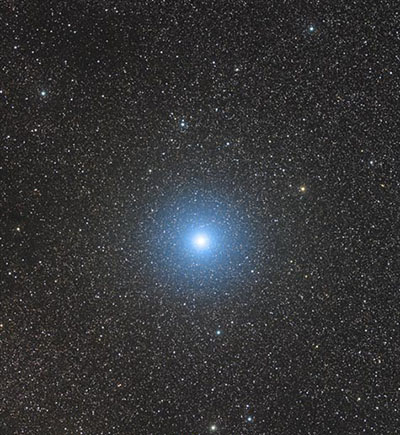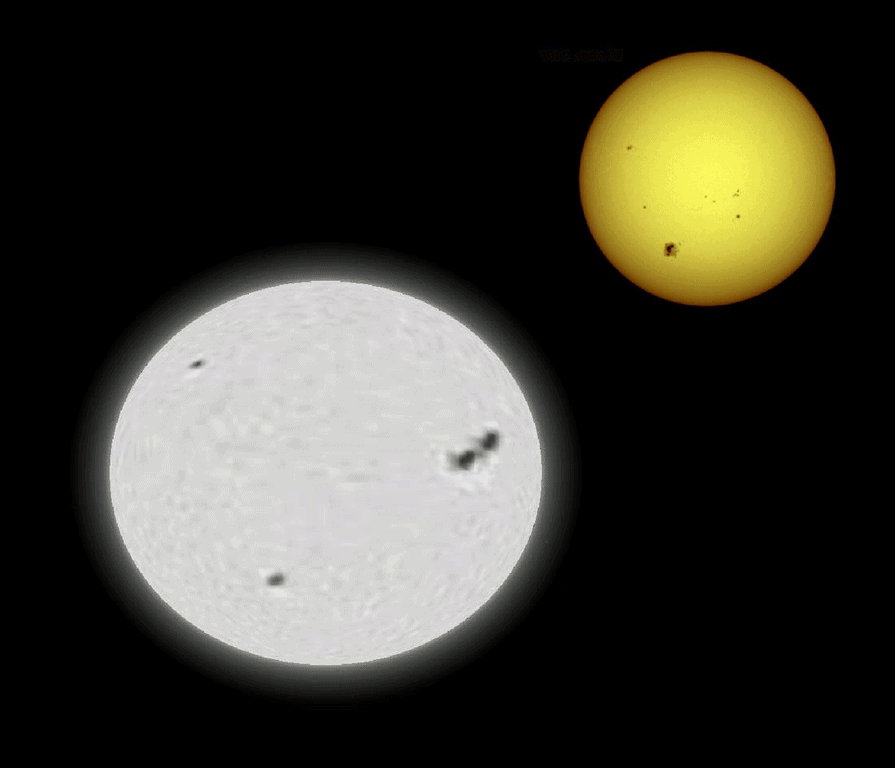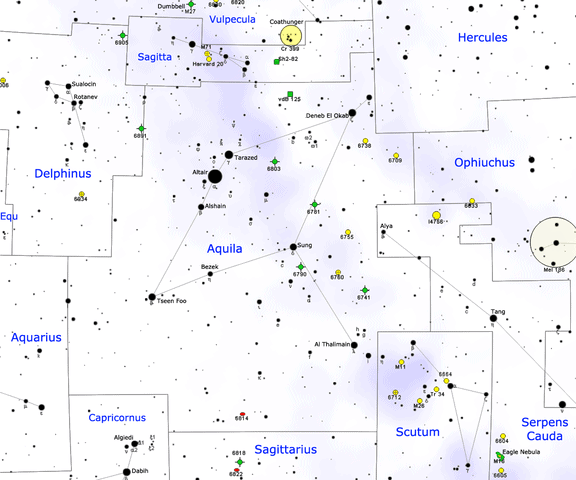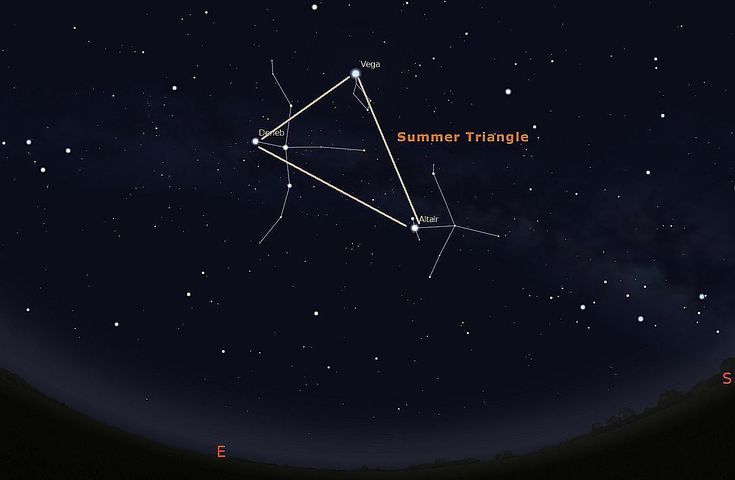Altair is the brightest star in the constellation of Aquila, and the twelfth brightest star in the night sky. It is one of the closest stars to us, that is visible to the naked eye.
Key Facts & Summary
- Altair is an A-type main-sequence star that has an apparent magnitude of 0.76. Its spectral type is A7 V – thus it is a white main-sequence dwarf.
- Altair is at around 16.7 light-years / 5.13 parsecs away from the Sun.
- It is one of the vertices of the Summer Triangle asterism, located in the southern apex of the asterism– the other two vertices are marked by Deneb and Vega.
- Currently, Altair is located in a G-cloud – a nearby interstellar cloud which is an accumulation of gas and dust.
- Altair has an unusually fast rotational velocity of approximately 286 km / 177.7 mi per second. This is a significant fraction of the star’s breakup speed of 400 km / 248.5 mi per second.
- Because Altair has such a rotational speed, its poles are flattened as a consequence. Some estimates suggest that Altair’s flattening is about 14%.
- Altair has almost double the Sun’s mass, at an estimated 1.79 solar masses.
- Altair is 10.6 times brighter than our sun and has around 1.63 solar radii.
- Altair completes one spin on its axis in around 8.9 hours, around 67 times faster than our sun, and has a surface gravity of 4.29 cgs.
- The star is much hotter than our sun, with average temperatures ranging from 6.900 to 8.500 K.
- Altair has an estimated age at around 1.2 billion years and its corona is a weak source of X-ray emissions.
- The most active regions of X-ray emissions in Altair are located near the star’s equator probably due to convection cells forming at the cooler equator.
- The star exhibits some faint variations in luminosity, as such it was marked as a Delta Scuti variable star.
The name Altair has been used since medieval times. It comes from an Arabic phrase that roughly translates to “the flying eagle.” For the Arabs, Altair was part of an asterism which also contained the second and third brightest stars of the Aquila constellation and was named Al Nesr Al Tair.

The name was later translated into Latin as Vultur Volans or the Flying Vulture. The ancient Sumerians and Babylonians knew Altair as the star of the eagle. Together with Vega in the constellation of Lyra and Deneb in the constellation of Cygnus, Altair forms the Summer Triangle, a prominent asterism of the northern hemisphere.
Formation
Altair formed roughly 1.2 billion years ago from a molecular cloud or nebula of gas and dust. Gravity pulled together the swirling gas and dust together to form the eagle star we today now know as Altair. The star seems to have an abundance of iron, and almost twice the heavy elements of the sun.
Distance, Size, and Mass
Altair is at around 16.7 light-years / 5.13 parsecs away from the Sun. It is one of the closest stars to us, visible to the naked eye.

Altair has almost double the Sun’s mass, at an estimated 1.79 solar masses, and almost double the Sun’s radius, at around 1.63 solar radii at its poles and at around 2.03 solar radii at its equator due to its oblate shape caused by high rotational speeds. Thus, Altair’s polar diameter is at around 25% smaller than its equatorial diameter.
Other Characteristics
Altair is almost 11 times brighter than our sun. It has a visual magnitude of 0.77 and an absolute magnitude of 2.21. It is a variable type of star, classified as a Delta Scuti variable. Its variations in luminosity occur over periods that range from 0.8 to 1.5 hours.
Altair completes one spin on its axis in around 8.9 hours, our Sun for comparison completes one equatorial rotation at around 25 days. Its fast rotational velocity has been estimated to be around 286 km / 177.7 mi per second.

Because of its rotational speed, its poles are flattened and the temperatures on its surface vary from its equator to its poles. Temperatures have been estimated to range from 6.900 K at the equator up to 8.500 K at the poles. It may be that due to these temperatures and variations, convention cells who migrate from the hot regions to the cooler regions may produce low-level X-ray emissions.
Location
Altair is located in the constellation of Aquila – the eagle. It forms a line of stars known as the Shaft of Aquila along with the second and third brightest stars of the constellation. The other two stars are Alshain and Tarazed.

The eagle is strongly associated with the constellation of Aquila. In Greek mythology, Zeus’s thunderbolts were carried by a bird which represented him, that bird was an eagle and the symbol of Zeus. One mythology depicts the eagle kidnapping a Trojan boy named Ganymede.
The eagle took Ganymede to Olympus, where he would serve as the cupbearer to the gods due to his beauty. Ganymede was represented by the constellation of Aquarius.

The Future
Altair currently spins at around 90% of the speed it would take for the star to be blown apart. If some internal or external events do indeed push the star to its breaking limit, the twelfth brightest star in the night sky will be gone.
Apart from this, Altair is unusually bright for its spectral type. As such, it is believed that the star is on its way into becoming a subgiant star – evolving off the main sequence. It will exhaust its core hydrogen and turn into a red giant or Cepheid variable before blowing off its outer layers to reveal a remnant core as a white dwarf.
Did you know?
- When it comes to Western astrology, Altair was ill-omened, portending danger from reptiles.
- The Bugis sailors of Indonesia use Altair as a means of navigation and call it the eastern star.
- Altair appears to have three visual companions that appear along the same line of sight – but they are farther away and not physically related.
- Many stories depict Altair as an eagle, but in Chinese folklore, the stars Altair and Vega represent a cow herder and a weaving girl who meet each other only after crossing a celestial bridge formed by a flock of magpies over the star Deneb.
- The Koori aboriginal people of Australia knew Altair as Bunjil – a wedge-tailed eagle who had the other 2 brightest stars in the constellation of Aquila, as his wives.
- Aquila, among many other stars, were cataloged in the 2nd century by the Greek astronomer Ptolemy.
- Aquila is the southernmost star in the Summer Triangle and can be seen between latitudes of +90 and -75 degrees.
- Probably the best time to view Aquila is in the summer to autumn months when it rises at around 90 minutes after sunset. By September’s end, the star approaches the meridian as night falls and by the end of the year, it disappears quicker – less than 3 hours after sunset.
Sources:
Image source:
- https://www.lifeharmonized.com/wp-content/uploads/2016/11/altair-eagle-star-life-harmonized.jpg
- https://upload.wikimedia.org/wikipedia/commons/thumb/7/7f/Altair-Sun_comparison.png/895px-Altair-Sun_comparison.png
- https://en.es-static.us/upl/2015/08/altair-800.jpg
- https://upload.wikimedia.org/wikipedia/commons/thumb/7/7d/Aquila_charta.png/576px-Aquila_charta.png
- https://i.pinimg.com/originals/19/91/d7/1991d72a0e6fa0da07dde85b71e35018.jpg
